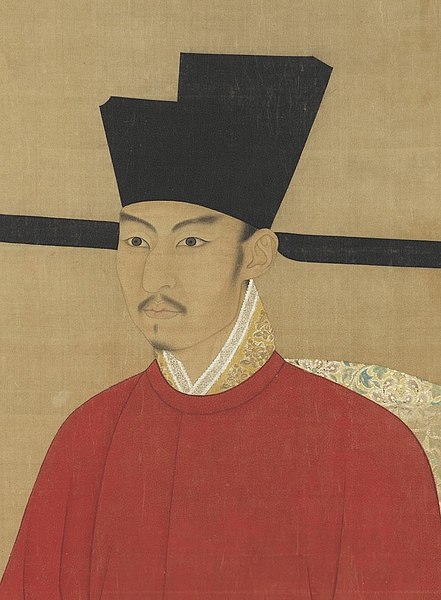
Image Source: Public Domain
About Emperor Zhezong
Lifespan: 1077 – 1100 A.D
Reign Years: 1085 – 1100 A.D
Given Name: Zhao Xu
Reign Name: Zhezong

Image Source: Public Domain
Lifespan: 1077 – 1100 A.D
Reign Years: 1085 – 1100 A.D
Given Name: Zhao Xu
Reign Name: Zhezong
Emperor Zhezong was the seventh Song Dynasty emperor of China. He ruled from 1085 until death in the year 1100 and was succeeded by Emperor Huizong, his younger half-brother. This was because Zhezong’s son died prematurely, and he had no one else to take over the throne.
This Song emperor was the sixth son of Emperor Shenzong. He ruled at the age of nine, under the assistance of Grand Empress Dowager Gao, his grandmother.
Go back in time and follow the timeline and emperors of the Song Dynasty.
Read MoreSince the Song Emperor Zhezong was still young, his regent, Grand Empress Dowager Gao, led for the time being. She appointed a few conservatives like Sima Guang as the Chancellor. He prevented new policies set by Wang Anshi to push through before his death in 1086.
Although he was the seventh Song Dynasty emperor, Zhezong was powerless because of Grand Empress Dowager Gao. Only after she died in 1903 was he able to reinstate the reforms of Wang Anshi. It was also the time when he decreased the influence of the late Sima Guang.
When he could finally rule, Emperor Zhezong lowered the people’s taxes and stopped negotiating with the Western Xia state. He resumed the armed conflict with them, which eventually led Western Xia to get into a more peaceful situation with the Song.
However, the seventh Song Dynasty emperor couldn’t stop the fights between the conservative and liberal members of his government. In fact, their arguments and misunderstandings intensified during his time.
The court members were divided, which greatly contributed to the Song’s demise in the 12th century.
After continuous attempts, the Song emperor Zhezong was able to relax the tension between the groups. They were able to achieve a bit of stability, which, unfortunately, didn’t prevent old issues from recurring.
A few from the conservatives group refused to shift to the extreme opposite of their beliefs. However, they were silenced at some point. When Emperor Zhezong took control, he managed to undo what his empress dowager set onto the palace.
It was considered as a breath of fresh air since reforms were restored. Plus, the period was able to last until the end of the Bei Song.
Despite the positive things that occurred, the Song couldn’t escape the court’s dislocation, leading to a demoralized society. Moreover, the reform movement that was restored was practically useless without the original idealism.
Because of these, adequate grounds were gathered by the conservative group to blame these reforms for the dynasty’s fall.
In May 1099, the seventh Song Dynasty emperor fell ill, wherein the constant symptoms were constipation and coughing. Despite taking a lot of medications, the Song emperor didn’t get any better. With that, he asked his councilors to recommend good physicians.
One of the councilors recommended a physician named Geng Yu. He gave the emperor numerous advice for his health to get better, yet these still didn’t work.
In July, his constipation was replaced by something more severe. It was constant diarrhea that even prevented him from getting up to take his medicine. Because of this, the physician suggested spleen-warming pills, which was something that Zhezong’s mother approved of.
The weather change improved Zhezong’s health, allowing him to attend his son’s celebration. However, his sickness suddenly returned, so Emperor Zhezong canceled all his audiences for a total of two days.
Eventually, he died in the year 1100 in Kaifeng. Zhezong was succeeded by his younger brother since his son died even before him. His successor, Huizong, was a great supporter of the arts and was a great artist too.
However, these skills and knowledge weren’t adequate to make him a good ruler.
Huizong became overly indulgent in his pleasures and became irresponsible with state affairs.
This rare celadon jar from the ancient Song Dynasty features a beautiful all-olive green design, smooth and shiny, with a firm base from which grows an asymmetrically oval body with elegant grooved borders to a modest, slightly raised rim.
Buy Now!This rare preserved Song Dynasty celadon plate has a design devoid of decoration that makes it look like a beautiful, untouched piece of jade. Its bottom rests on a base that grows in layers around a small foot that grows along fine grooved borders.
Buy Now!This rare Song Dynasty ewer possesses an irresistible natural charm that exudes simplicity and grace in every part. It has an uncluttered base with a small foot that gives rise to a firm, sturdy body, devoid of any more decoration than a simple protruding medallion.
Buy Now!Join the VIP club, Get Auction notification, special offers and more!